NIOS Class 10 Economics Chapter 19 An Overview of Indian Economy Solutions to each chapter is provided in the list so that you can easily browse through different chapters NIOS Class 10 Economics Chapter 19 An Overview of Indian Economy and select need one. NIOS Class 10 Economics Chapter 19 An Overview of Indian Economy Question Answers Download PDF. NIOS Study Material of Class 10 Economics Notes Paper 214.
NIOS Class 10 Economics Chapter 19 An Overview of Indian Economy
Also, you can read the NIOS book online in these sections Solutions by Expert Teachers as per National Institute of Open Schooling (NIOS) Book guidelines. These solutions are part of NIOS All Subject Solutions. Here we have given NIOS Class 10 Economics Chapter 19 An Overview of Indian Economy, NIOS Secondary Course Economics Solutions for All Chapters, You can practice these here.
An Overview of Indian Economy
Chapter: 19
MODULE 7: INDIAN ECONOMY
TEXTBOOK QUESTIONS (SOLVED)
INTEXT QUESTIONS 19.1
Q.1. Compare the methods of production of Indian textile handicrafts with that of the British.
Ans. Textiles used labour, while British textile used machines for production.
INTEXT QUESTIONS 19.2
Q.1. Give the meaning of famine.
Ans. Famine: It is the situation wherein many people do not get food to eat and die from hunger and diseases.
Q.2. Why were the British exporting foodgrains?
Ans. The British were exporting food-grains due to following reasons:
(i) To earn revenue for itself by exporting foodgrains to other countries.
(ii) To feed its soldiers who were fighting wars in different parts of the world.
INTEXT QUESTIONS 19.3
Q.1. Distinguish between permanent and temporary settlement.
Ans. Under permanent settlement, land revenue to be collected was permanently fixed, whereas under temporary settlement, land revenue was changed after 20-25 years of time.
Q.2. Write three sentences about the zamindars.
Ans. Zamindars: Zamindars were intermediaries between the British Government and common people. They were appointed in eastern parts of India. Their job was to collect revenue in the form of rent, taxes etc. from the village farmers and other households and submitted that revenue with the government. Later on they became rich and powerful at the cost of common man with the blessings of British Government.
INTEXT QUESTIONS 19.4
Q.1. Find the percentage increase in per capita income in 2009-10 over 2008 from table 19.1 above i.e.
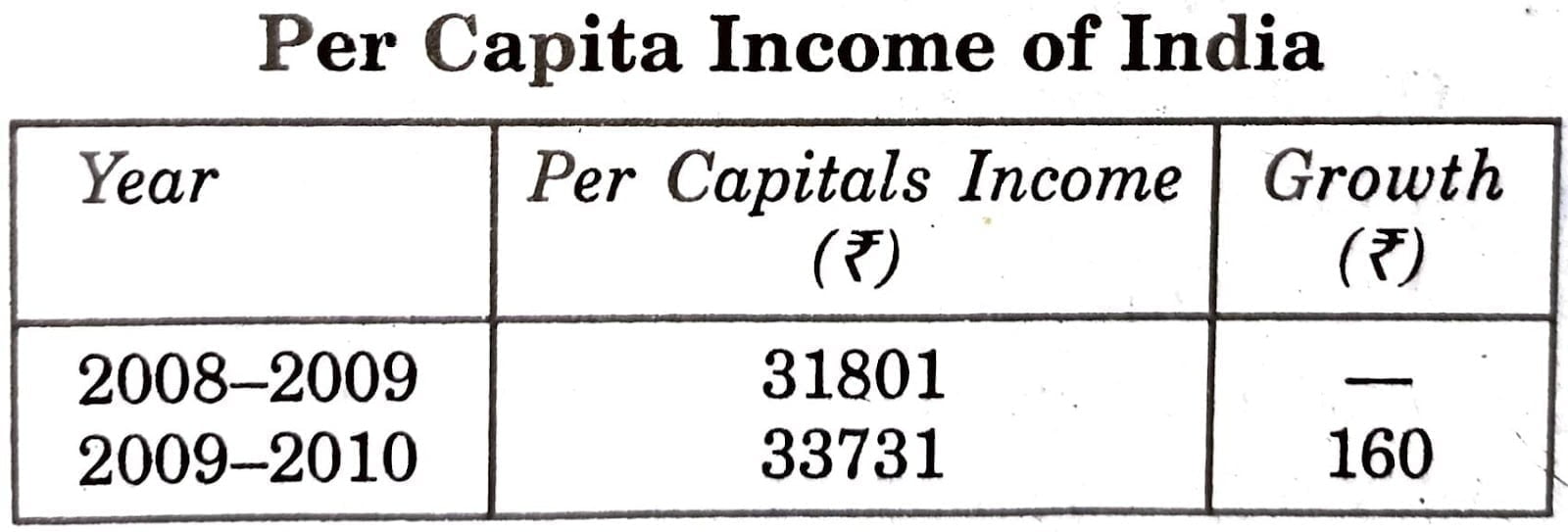
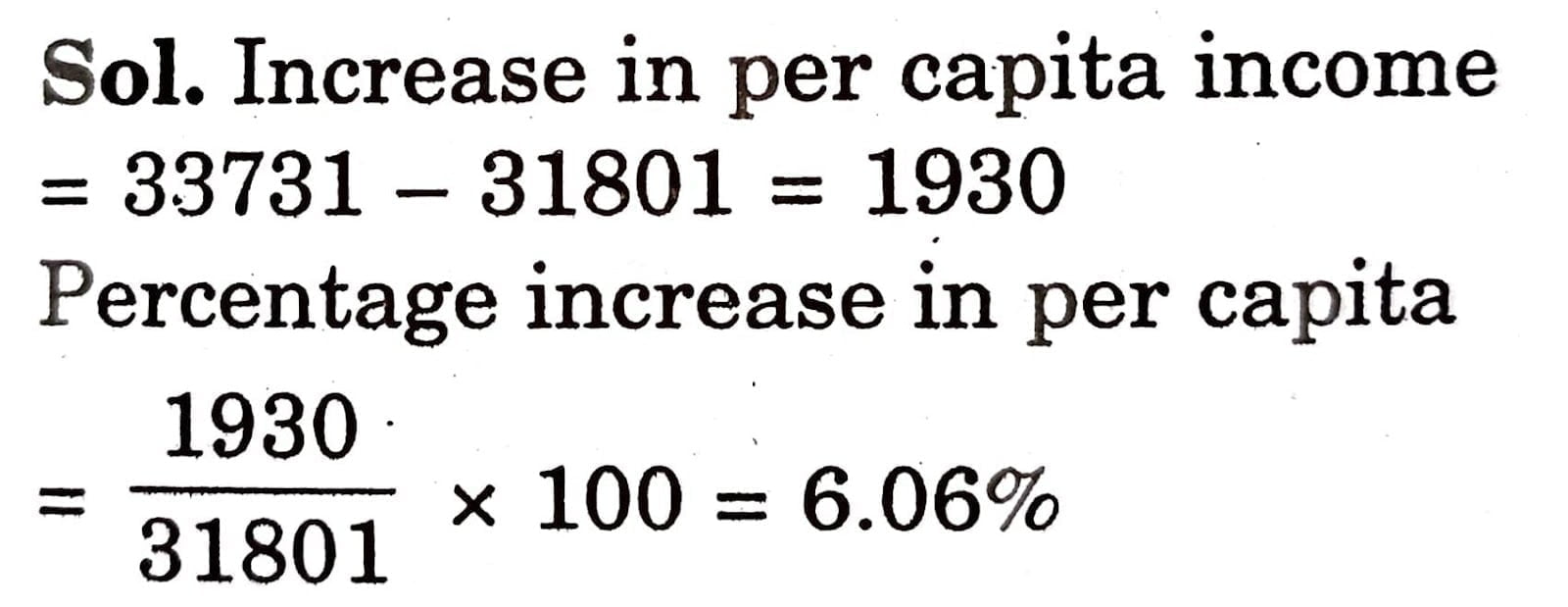
Q.2. Define per capita income.
Ans. Per capita income may be defined as per average national income. It is calculated by dividing national income by population. In equation,

Q.3. What was India’s per capita income in 2009-10?
Ans. ₹ 33,731.
INTEXT QUESTIONS 19.5
Q.1. Do you think poverty and unemployment are linked?
Ans. Yes.
Q.2. Compare the figures for Odisha and Punjab as given Table i.e., Poverty Situation in some states in India:
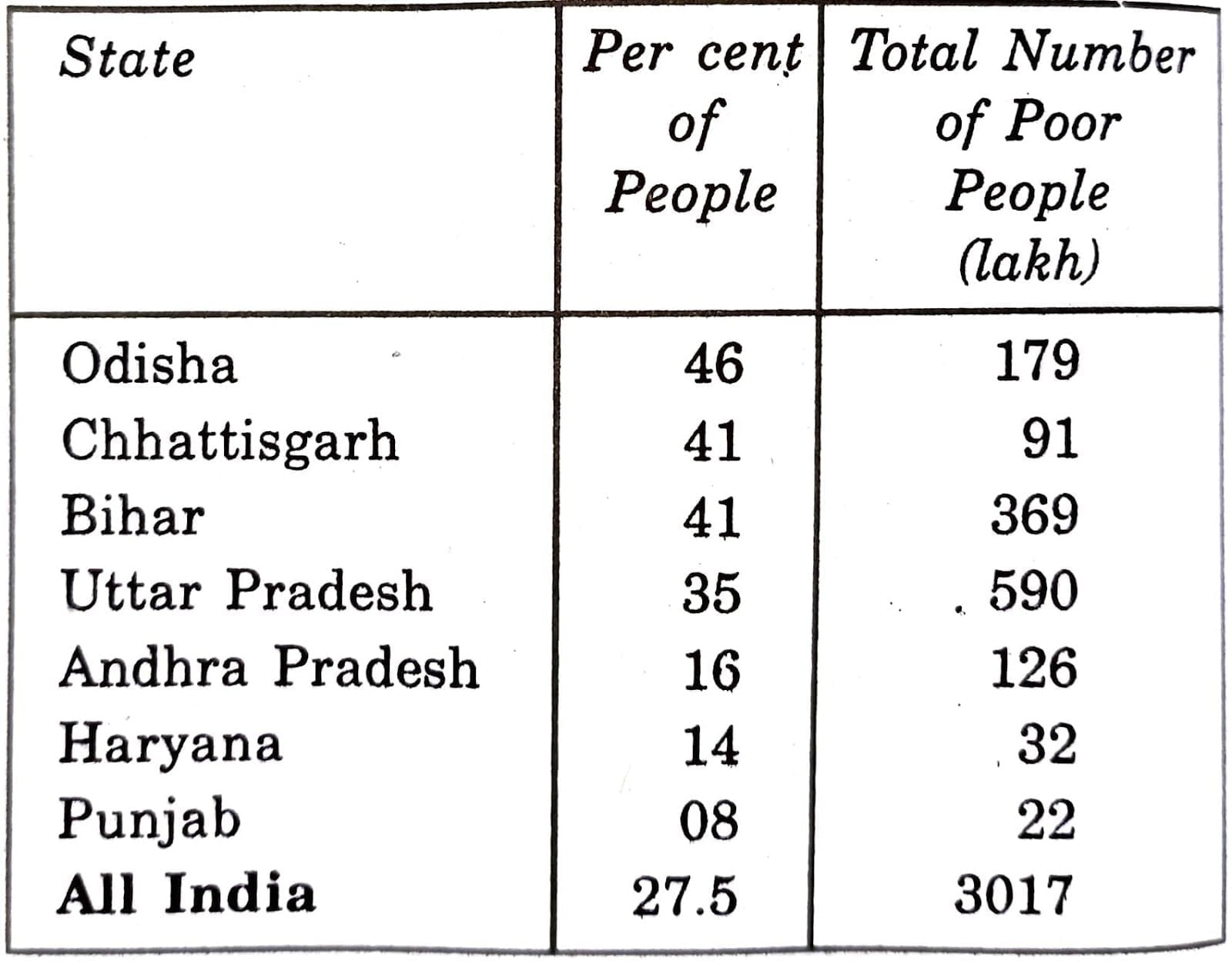
Ans. Odisha has 46 per cent of its population as poor whereas Punjab only 8 per cent population who are poor. Hence Punjab is richer than Odisha.
TERMINAL EXERCISE
Q.1. What do you mean by temporary settlement?
Ans. Temporary settlement means revision of land revenue every 25-30 years.
Q.2. Why did the British want to be cash crops cultivate?
Ans. The British wanted cash crops to cultivate so that they could send them to England to use them as raw materials.
Q.3. Two reasons for the occurrence of famines in India.
Ans. (i) Poor people had not enough money to purchase food grains from the market.
(ii) Indian farmers were encouraged to cultivate cash crops on their fields. This led to fall in production of foodgrains. Because less area was available for their cultivation.
Q.4. Cite one positive aspect of India’s population.
Ans. One positive aspect of India’s population is that the number of young people is very high as compared to other nations in the world. Youth are full of energy and strength and expected to perform better as they have ability to work more. It also indicates low dependency ratio.
Q.5. From the definition of per capita income can you give one reason of its slow growth?
Ans. Population in India is very fastly increasing.
Q.6. Give a brief account of famines during British period. What are reasons?
Ans. A brief of Famines during British Period: There had been frequent occurrence of famines during the British rule in India. Famines occurred nearly. 33 times during the whole British period. The most devastating famine was the Bengal famine of 1943. More than 1.9 million people died at this time due to lack of food.
Reasons of Famine during British Rule: Following were main reasons of famine during British rule:
(i) Irrigation facilities were not available.
(ii) Agriculture was dependent on rainfall which was uncertain.
(iii) British government kept on exporting food grains to its native country for its own interest. It led to the shortage of foodgrains in India.
(iv) Poor people did not have enough money to purchase foodgrains from the market.
(v) Indian farmers were encouraged to produce cash crops on their land. It led to fall in production of foodgrains as less area was available for cultivation.
Q.7. Who were the intermediaries? Describe the role played by them.
Ans. Intermediaries: In order to collect revenue the British appointed Zamindars in Eastern part of India, Mahalwari in Western part and Ryotwari in South India. These persons were called intermediaries, because they used to act between British Government and common people.
Role of the Intermediaries: Following points show the role of the intermediaries:
(i) They used to collect revenue in the form of the rent, taxes etc. from the village farmers and other households and submitted that revenue with the government.
(ii) They used to keep a part of revenue collected before depositing it with the government.
(iii) They used to help the government in running the administration.
(iv) They became mini rulers in their respective areas.
Q.8. Why did the Government of India adopt Planning?
Ans. The Government of India adopted planning to achieve development.
Q.9. Do you think India is a poor country? Give reasons for your answer.
Ans. Yes, think that India is a poor country.
Following points are sufficient to prove that India is a poor country:
(i) Due to poverty there are beggars in the streets.
(ii) There are slums in towns and cities.
(iii) Children are working on the fields or in the street- side dhabas or employed in the houses or in factories etc.
(iv) No shelter for living.
(v) More than 30 crores of India’s population cannot afford his and her daily needs or necessities.
(vi) They are not able to eat even two square meals a day.
SOME IMPORTANT QUESTIONS FOR EXAMINATIONS
VERY SHORT ANSWER TYPE QUESTIONS
Q.1. For how many years did the British rule over India?
Ans. The British ruled over India for 200 years.
Q.2. What was the aim of the Britishers to rule over India?
Ans. The aim of the Britishers to rule over India was to exploit the resources of India and to take away as much as possible to England.
Q.3. Why did the British rule over India?
Ans. The British ruled over India for their gain.
Q.4. Why did the Britishers lay railway lines in India?
Ans. The Britishers laid railway lines in India so that things can be transported to port area for shipment to England.
Q.5. Who ruled over India before the Britishers came to India?
Ans. Emperors and kings ruled over India before the Britishers came to India.
Q.6. What was the impact of defeat of emperors and rulers on the towns and handicraft industry?
Ans. With the defeat of emperors and rulers, towns were destroyed and the handicraft industry faced closure.
Q.7. Name the goods required for
(i) making textile.
(ii) making prints on Textiles.
Ans. Cotton is required for making textile and indigo is required for making prints on textiles.
Q.8. What did the Britishers do to make the poor farmers of India to raise jute, sugarcane and groundnuts.
Ans. The Britishers offered money to poor farmers of India to raise jute, sugarcane and groundnuts.
Q.9. When and where did the most devasting famine occurs in India?
Ans. The most devastating famine occurred in 1944 in Bengal.
Q.10. On what factor did agriculture depend in India during the British period?
Ans. In India, agriculture depended on rainfall during the British period.
Q.11. Why did agriculture depend on rainfall during the british period?
Ans. Because irrigation facilities were not available.
Q.12. State any causes of out break of famine in India during the British period.
Ans. Two Reasons: (i) Export of food-grains.
(ii) Production of cash crops.
Q.13. What was the major occupation of people during British India?
Ans. Agriculture.
Q.14. What percentage of people depend on agriculture in British India?
Ans. More than 70% of people depended on agriculture in British India.
Q.15. What was main source of income of British Government in India?
Ans. Land Revenue.
Q.16. Under which land system land revenue to be collected was permanently fixed?
Ans. Under permanent settlement of land.
Q.17. What is temporary settlement?
Ans. Temporary settlement is that settlement under which land revenue was changed after 25 years.
Q.18. Who were appointed by the British in eastern part of India to collect revenue?
Ans. Zamindars.
Q. 19. Some positive things happened during British period. Name any two things.
Ans. (i) Introduction of Railways.
(ii) Establishment of first jute mill.
Q.20. What was per capita income during 2009-2010 in India?
Ans. ₹ 33731 i.e. 2811 per month.
Q.21. How is per capita income calculated?
Ans. Per capita income is calculated by dividing the National Income by population.
Q.22. How much has been there growth in population in last 60 years?
Ans. Population has grown by more than three times in last 60 years.
Q.23. What was population of India at of independence (in 1947)?
Ans. India’s population was 35 crores in 1947.
Q.24. What is the population of India according to census 2011?
Ans. 121 crores.
Q.25. What is the place of India in the world in terms of population?
Ans. Second.
Q.26. Name the three most populous states in India.
Ans. (i) Uttar Pradesh.
(ii) Maharashtra. and
(iii) Bihar.
Q.27. What was population of Utter Pradesh in 2011?
Ans. 19.9 crores.
Q.28. Out of Indian states, which state is the most poor?
Ans. Odisha.
Q.29. Which state of India has the maximum number of poor people?
Ans. Uttar Pradesh.
Q.30. When was First Five Year Plan launched?
Ans. In 1950.
Q.31. Write down the duration of First Five Year Plan.
Ans. 1951-1956.
Q.32. State the reasons of manifold increase in the amount of expenditure from first plan to eleventh plan.
Ans. Reasons: (i) Increase in population.
(ii) Increase in wants. and
(iii) Increase in prices in market.
Q.33. During the period of 1966-69, there was no five year plan. There were only annual plans. Why so?
Ans. Following were reasons for this:
(i) Lack of monetary and other resources due to war against China in 1962 and against Pakistan in 1965.
(ii) Draught situation.
Q.34. When and with which plan, did India restart five year plan?
Ans. India restarted five year plans in 1969 with the fourth plan.
Q.35. Why sixth plan started and the period of 1979-80 converted to annual plan?
Ans. Sixth plan was started in 1980 and the period of 1979-80 was converted to annual plan.
Q.36. State the amount allocated to meet the expenditure on various sectors in the First Five Year Plan.
Ans. ₹ 2070 crores.
Q.37. How many distinct phases has the story of Indian economy?
Ans. The story of Indian economy has two distinct phase:
(i) The economy during British period.
(ii) The economy after independence.
Q.38. Name any three cash crops.
Ans. (i) Cotton.
(ii) Jute. and
(iii) Sugarcane.
Q.39. Name any three food crops.
Ans. (i) Wheat.
(ii) Rice.
(iii) Jowar.
Q.40. Name any notable features of Indian economy at the end of British rule.
Ans. (i) Decline of handicrafts industry.
(ii) Production of cash crops.
Q.41. What is considered as the most important contribution of the Britishers?
Ans. Introduction of railways.
Q.42. How was agriculture sector exploited by the British rule?
Ans. Agriculture sector was exploited through Zamindari system and forced commercialisation of agriculture.
Q.43. How many plans have been completed in India so far?
Ans. Eleven.
Q.44. Why were jute, sugarcane and ground nuts in great demand in England?
Ans. Jute, sugarcane and groundnuts were in great demand in England as they were all needed in factories there.
Q. 45. Why are jute, sugarcane and groundnuts are called cash crops?
Ans. Jute, sugarcane and groundnuts are called cash crops as they are used in factories as raw materials to produce goods.
Q.46. Where did the British supply cash crops?
Ans. The British supplied cash crops to factories in England.
Q.47. Where did the British send food from India?
Ans. The British sent food from India to those countries where their soldiers were fighting to capture territories.
Q.48. Why did the production of cash crops lead to fall in production of food- grains?
Ans. Because due to production of cash crops, less area was available for the cultivation of foodgrains.
Q.49. Who became mini rulers in that respective areas during the British period?
Ans. Zamindari, Mahalwari and Ryotwaris became mini rulers in that respective areas.
Q.50. What did the Zamindari, Mahalwari and Ryotwaris do when persons failed to give revenue?
Ans. They used force to take away belongings of persons who failed to give revenue.
Q.51. Who were appointed in western part of India by the Britishers to collect revenue from the villagers?
Ans. Mahalwari.
Q.52. Which land revenue system was introduced in South India by the Britishers?
Ans. Ryotwari system.
Q.53. Why were Zamindars, Mahalwari and any Ryotwari appointed by the British called intermediaries?
Ans. Because they used to act between British Government and common people.
Q.54. When were first jute mill, the first cotton mill and first coin mill established in India by the British Government?
Ans. Between 1850-1855.
Q.55. Who first established tele-communication, telegraph and post-offices in India for the first time?
Ans. The British Government.
Q.56. Why did new era begin in India’s history after its independence?
Ans. Because after independence, the governance of India became the responsibility of its people.
Q. 57. What does “the governance of India became the responsibility of its people its independence” mean?
Ans. It means that after independence people of India governed their country. They were the master of their country.
Q.58. By the year, 2012, how many five yea plan have been completed in India?
Ans. Eleven Five Year Plan.
Q.59. Which is the major indicator of men’s standard of living?
Ans. Income of an individual is a major indicator of his/her standard of living.
Q.60. Can a person with ₹ 2811 as his monthly income lead a decent life?
Ans. No, a person with ₹ 2811 as his monthly income cannot lead a decent life.
Q.61. Why should there be an increase in our income every year?
Ans. We need increase in our income in every year due to
(i) increase in wants with passage of time.
(ii) increase in the prices of goods needed by us. and
(iii) our desire to help each other at the times of needs.
Q.62. Can we help others which we want to do if we are not able to earn more ourselves to satisfy our own increase in wants?
Ans. No.
Q.63. Which is the populous country in the world?
Ans. China.
Q. 64. Why does more people imply?
Ans. More people implies more mouths to eat and more foodgrains to be produced.
Q.65. Why are there slums in cities and beggars in the streets in India?
Ans. Because our government is not bestowed with sufficient resources to provide basic facilities to the growing population.
Q.66. Name any one of the largest countries in the world as per land area.
Ans. Brazil.
Q.67. population is almost equal to the combined population of which countries?
Ans. India’s population is almost equal to the combined population of USA, Japan, Indonesia, Pakistan and Bangla Desh.
Q.68. Why are Punjab, Haryana and Andhra Pradesh least affected by poverty?
Ans. Because the percentage of poor people in these states is lower as compared to Orissa, Bihar and Uttar Pradesh.
Q.69. What does the percentage of poor people tell us?
Ans. The percentage of poor people tells us about how many persons out of 100 poor.
Q.70. 30 crores of India’s population of 127 crore are poor. Calculate percentage of poverty in India.
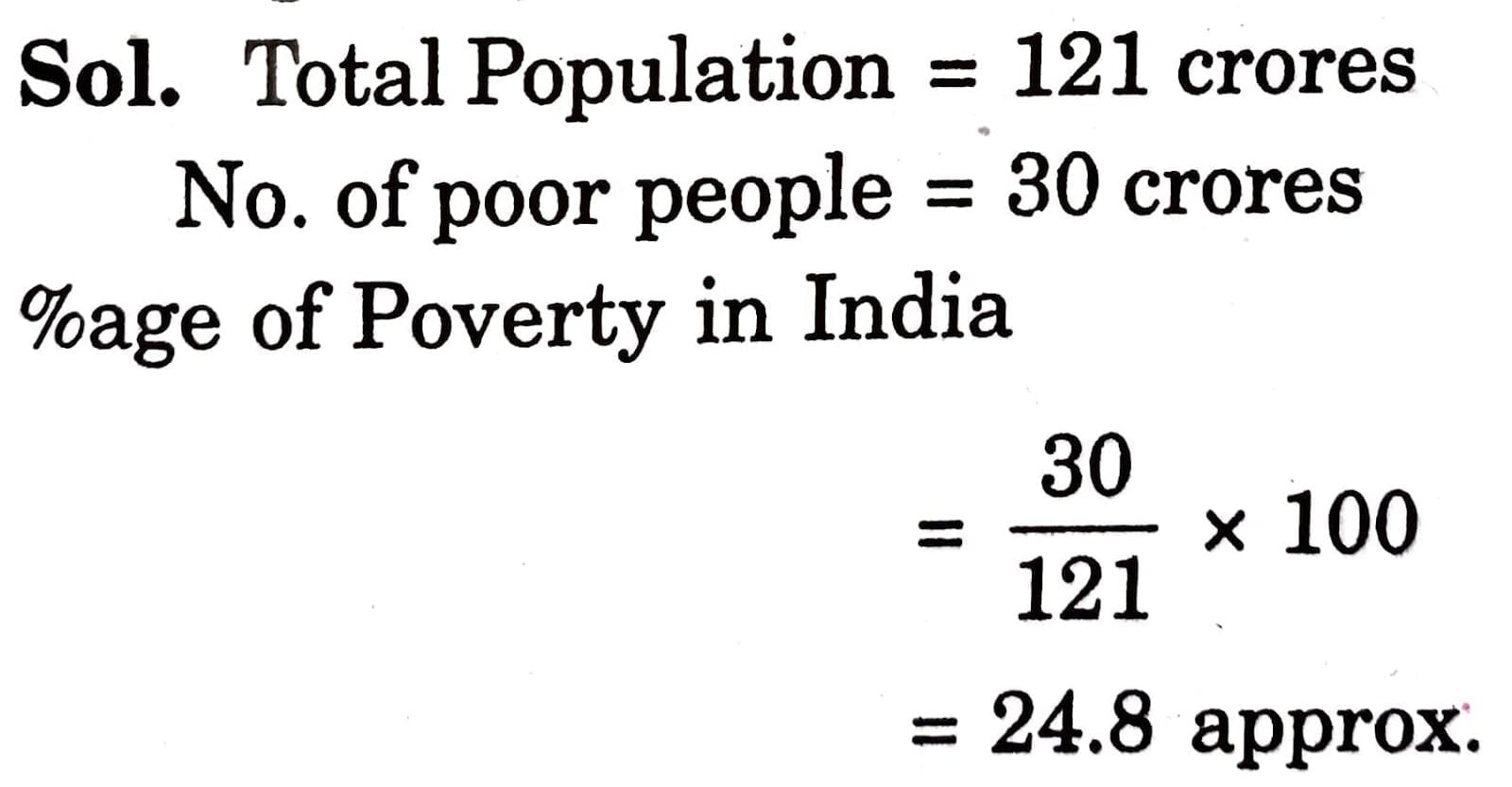
Q.71. Why is poverty a curse on humanity?
Ans. Poverty is a curse on humanity because a poor person cannot afford his/her daily needs or necessities to buy from the market.
Q.72. How many people are poor in the following states of India?
(i) Odisha.
(ii) U.P.
Ans. has 179 lakh poor people, while UP has 590 lakh people.
Q.73. What are the percentage of poverty in the following states: Odisha and U.P.
Ans. Odisha has 46% poor people, whereas UP has 35% poor people.
Q.74. In Spite of less poor people than that of U.P., Odisha has more poor people in percentage. Why is it so?
Ans. It is due to the fact the total population of U.P. is higher than that Odisha.
Q.75. What is the difference between absolute number of poor and percentage – of poor people?
Ans. Absolute number of poor people means total number of poor people whereas percentage of poor people means the number of poor people out of 100.
Q.76. Compare Haryana and Punjab terms of percentage of poor people.
Ans. Haryana has 14% poor people, whereas Punjab has 8% poor people.
Q.77. Compare Andhra Pradesh and Haryana in terms of total number of poor people.
Ans. Andhra Pradesh has 126 lakh poor people, whereas Haryana has 32 lakh poor people.
Q.78. Compare the figures of Odisha and Chhattisgarh as given in the following table:
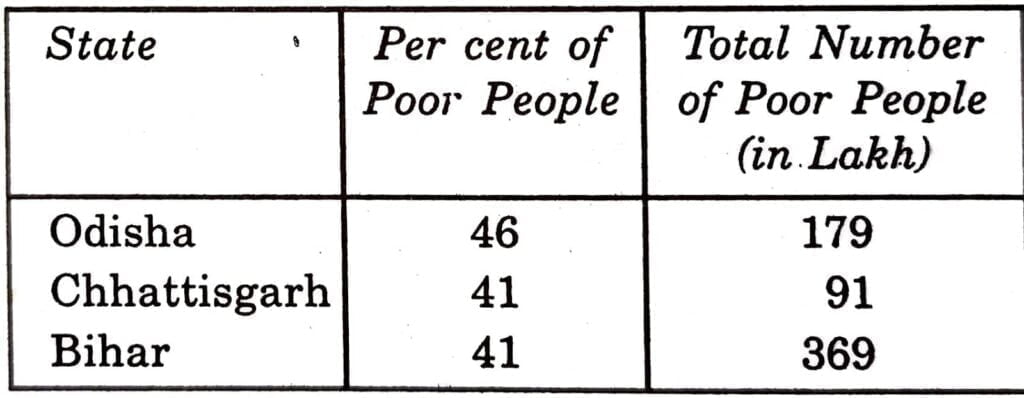
Ans. Odisha has 46% of its population as whereas Chhattisgarh has 41% of its population who are poor. Hence Chhattisgarh is richer than Odisha.
Q.79. Read the following table and state which state of India has its population equal to Mexico?
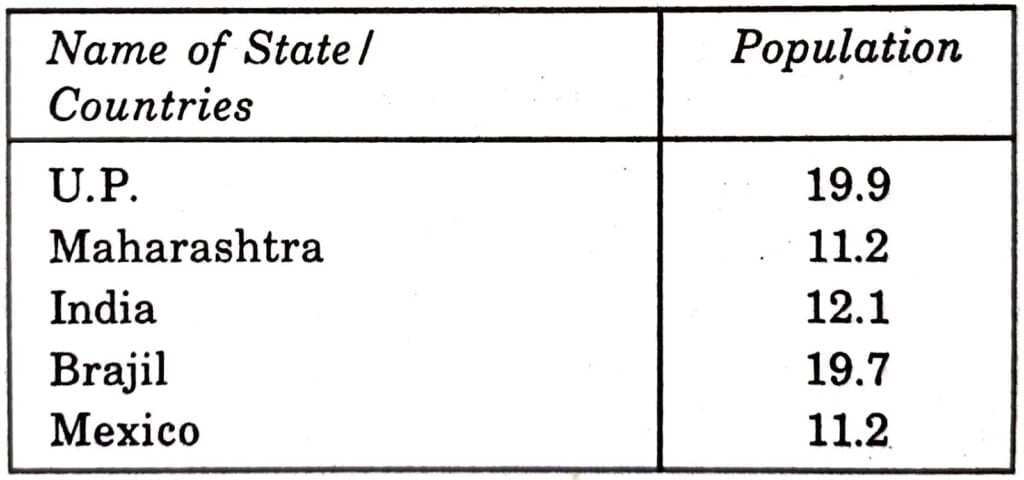
Ans. Maharashtra’s population is equal to that of Mexico.
Q.80. Which state of India has the highest percentage of poverty?
Ans. Odisha.
Q.81. Which state of India has the lowest percentage of poverty?
Ans. Punjab.
Q.82. Name any one factor leading a man to poverty.
Ans. Unemployment.
Q.83. Why is planning necessary to solve various problems?
Ans. Planning is necessary to solve various problems because the problems are not easy to solve in a day or so.
Q.84. Give the duration periods of the following five years plans:
(i) Fisth.
(ii) Tenth.
Ans. Duration periods of fifth and tenth five year plans are 1974-1979 and 2002-2007 respectively.
SHORT ANSWER TYPE QUESTIONS
Q.1. State some notable economic features of India at the end of British period.
Ans. Economic Features:
(i) Decline of handicraft industry.
(ii) Production of cash crops.
(iii) Famine and food shortage.
(iv) Rise of intermediaries in agriculture.
Q.2. State the reasons of decline of handicraft industry during the British rule.
Ans. Reasons:
(i) Defeat of kings and rulers who promoted the handicrafts.
(ii) Destruction of towns.
(iii) Change in the production technology i.e. the replacement of human labour by machines to produce goods.
(iv) Coming up of factories.
(v) Cheaper foreign textiles.
(vi) Help of the British Government to British producers only.
Q.3. State some reasons for occurrence of famine in British India.
Ans. Reasons of Occurrence of Famine in British India:
(i) Dependence of agriculture on rainfall.
(ii) Export of foodgrains by the British Government to its native country England and elsewhere even if there was local need for these things.
(iii) Poor people had not enough money to purchase food grains from the market.
(iv) Encouragement to Indian farmers to produce cash crops on their fields.
Q.4. Draw bar-diagram with the help of following table:
Poverty Situation in Some States in India
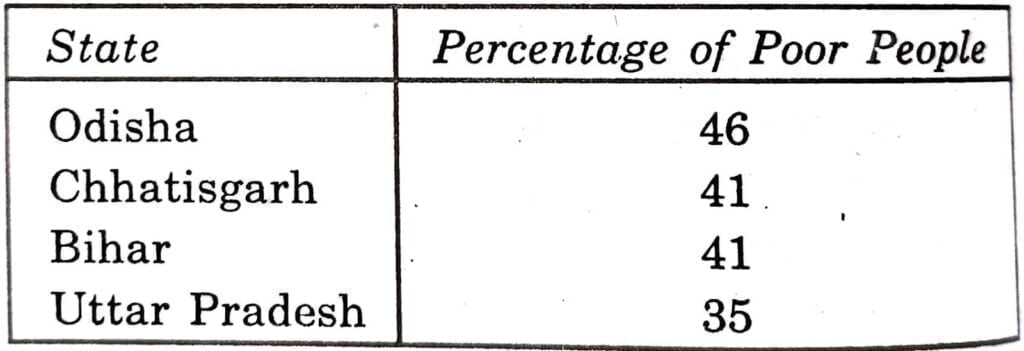
Ans.
Poverty Situation in Some States of India’s
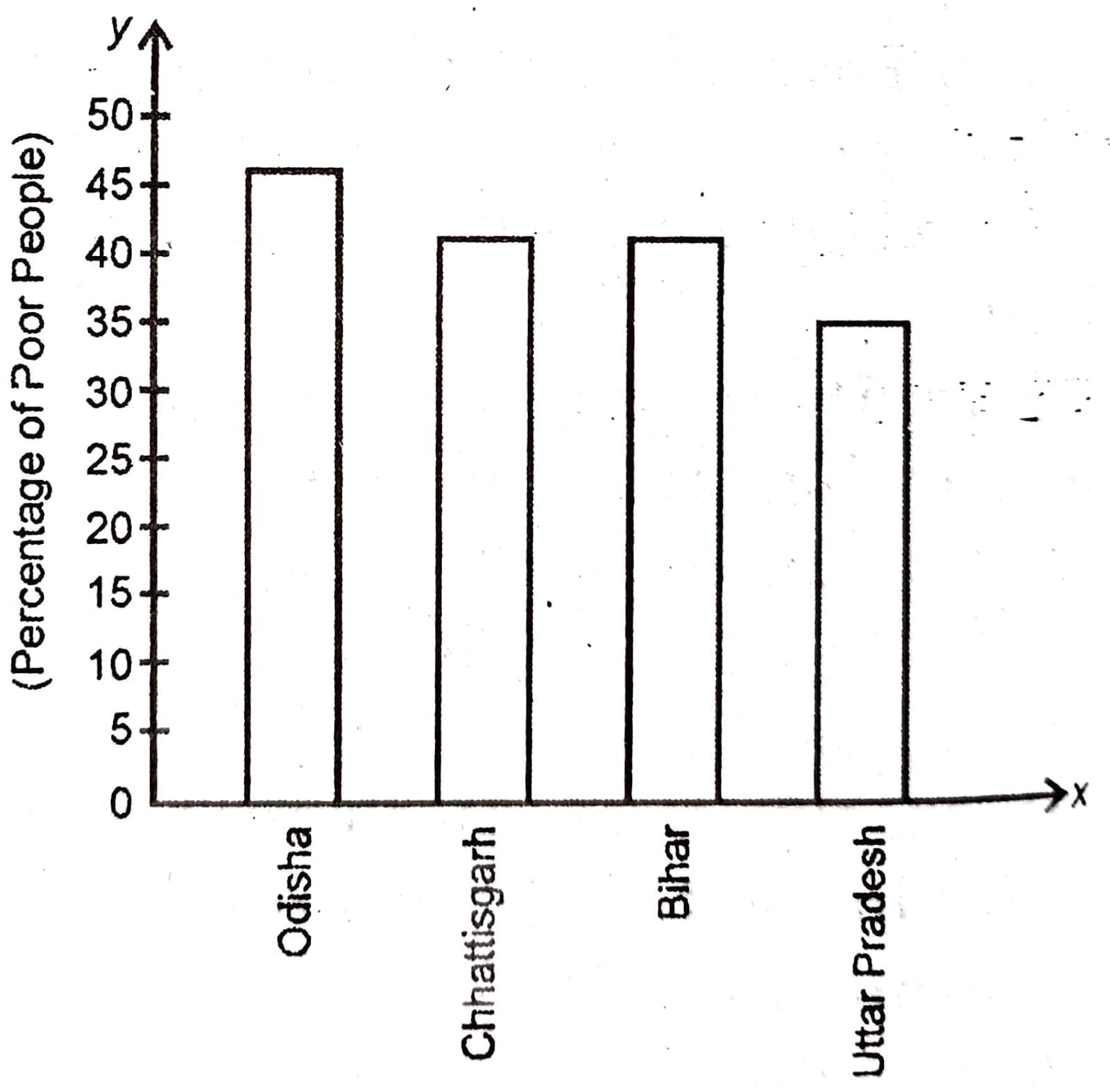
Q.5. Show the following data with the help bar diagram Poverty Situation in Some States in India.
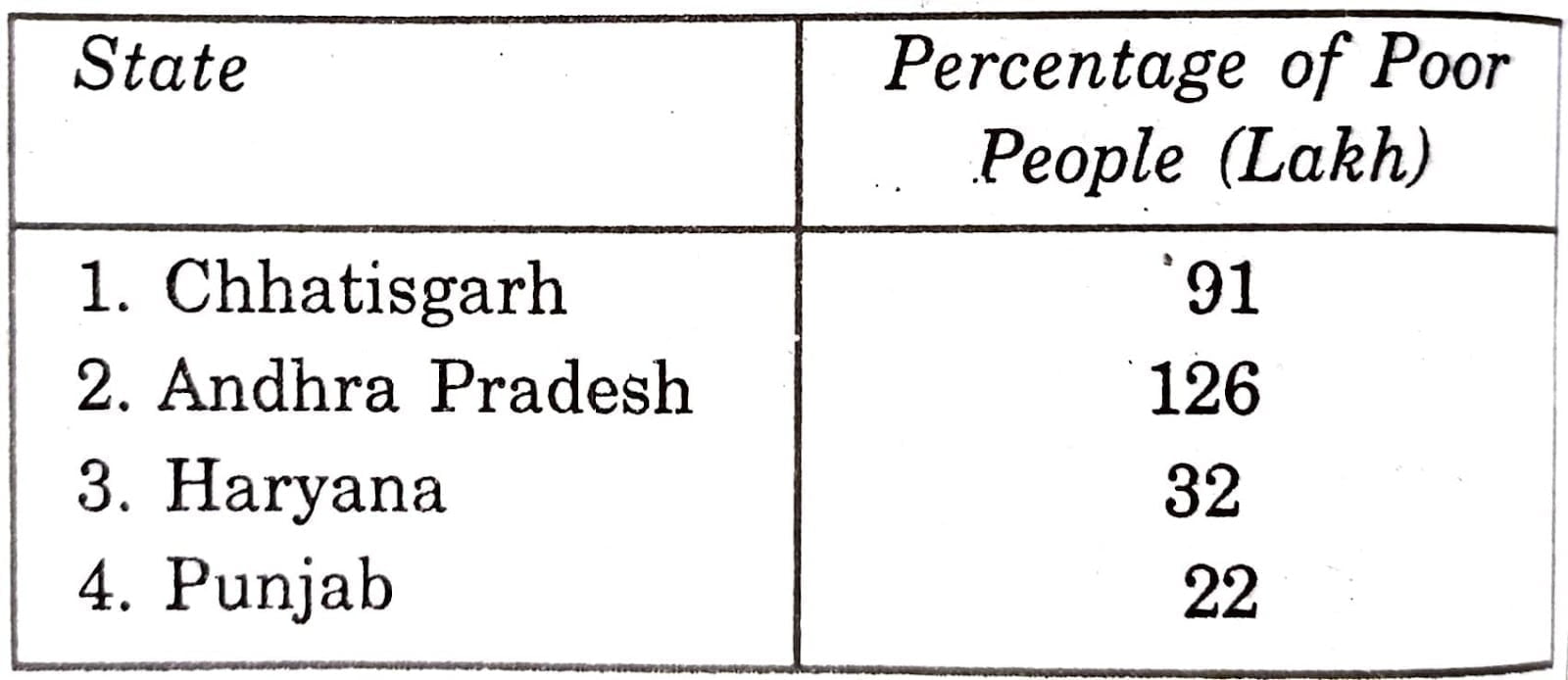
Ans.

Q.6. Below given is the duration of different Five Year Plans.

Read the above table and answer the following questions:
(i) When was Tenth Five Year Plan completed?
(ii) When was 11th Five Year Plan completed.
(iii) Mention the years when there were annual plans instead of five year plans.
(iv) The sixth plan was due on 1979. But it was started in 1980. Why?
Ans. (i) Tenth Five Year Plan was completed in 2007.
(ii) Eleventh Five Year Plan completed in 2012.
(iii) Annual plans were in the following years: 1966-67, 1967-1968, 1968-69, 1990- 91 and 1991-92.
(iv) Because there was change of government in 1979.
Q.7. From the following data calculate the monthly increase in per capita income:

Q.8. Write down the following states in ascending order in terms of number of poor people.
Odisha, Chhattisgarh, Bihar, Uttar Pradesh, Andhra Pradesh, Haryana and Punjab.
Ans. States in ascending order in respect of number of poor people:
(i) Punjab.
(ii) Haryana.
(iii) Chhattisgarh.
(iv) Andhra Pradesh.
(v) Odisha.
(vi) Bihar.
(vii) Uttar Pradesh.
Q.9. Draw a line series graph with the help of following data:
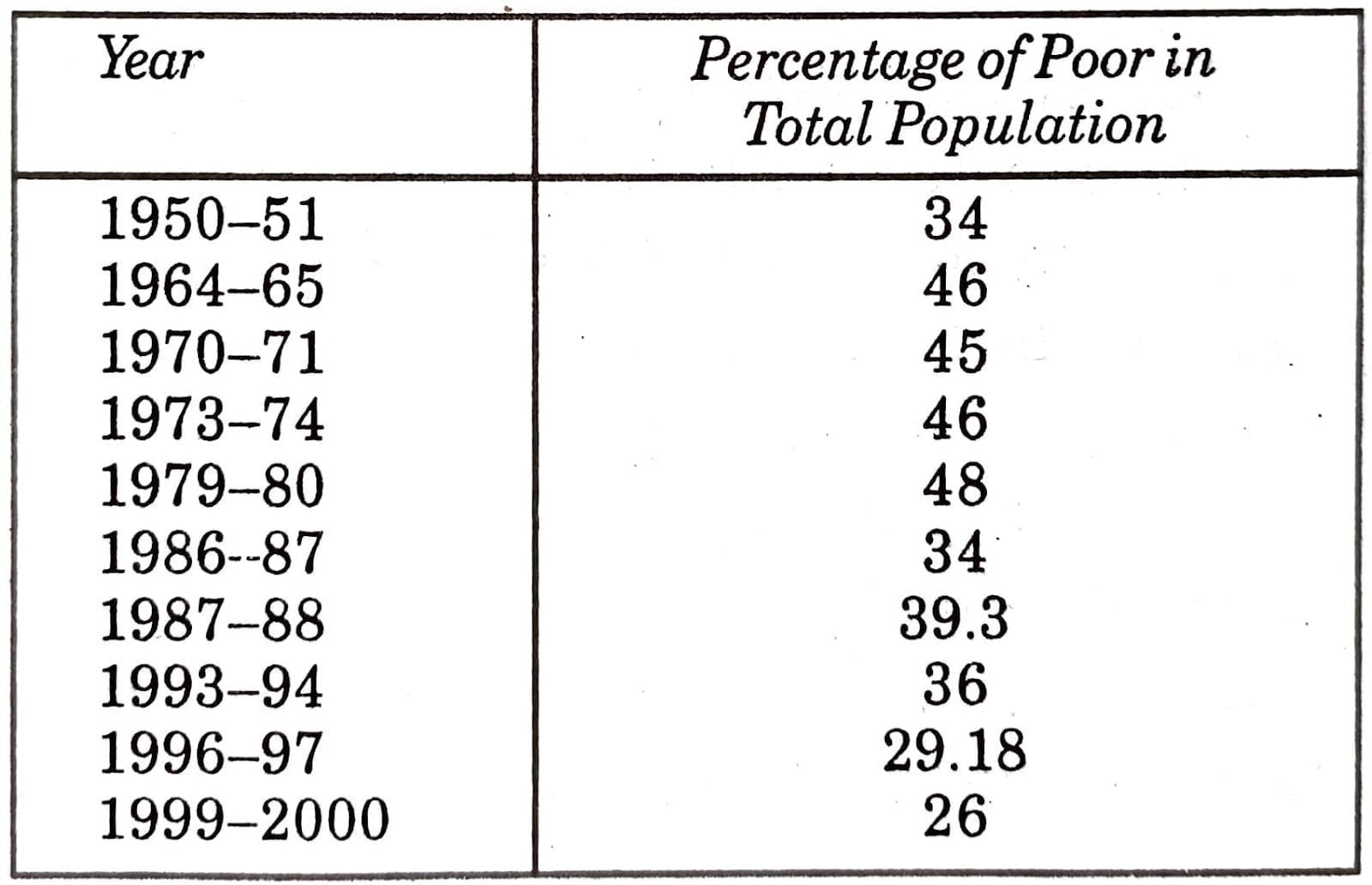
Ans.
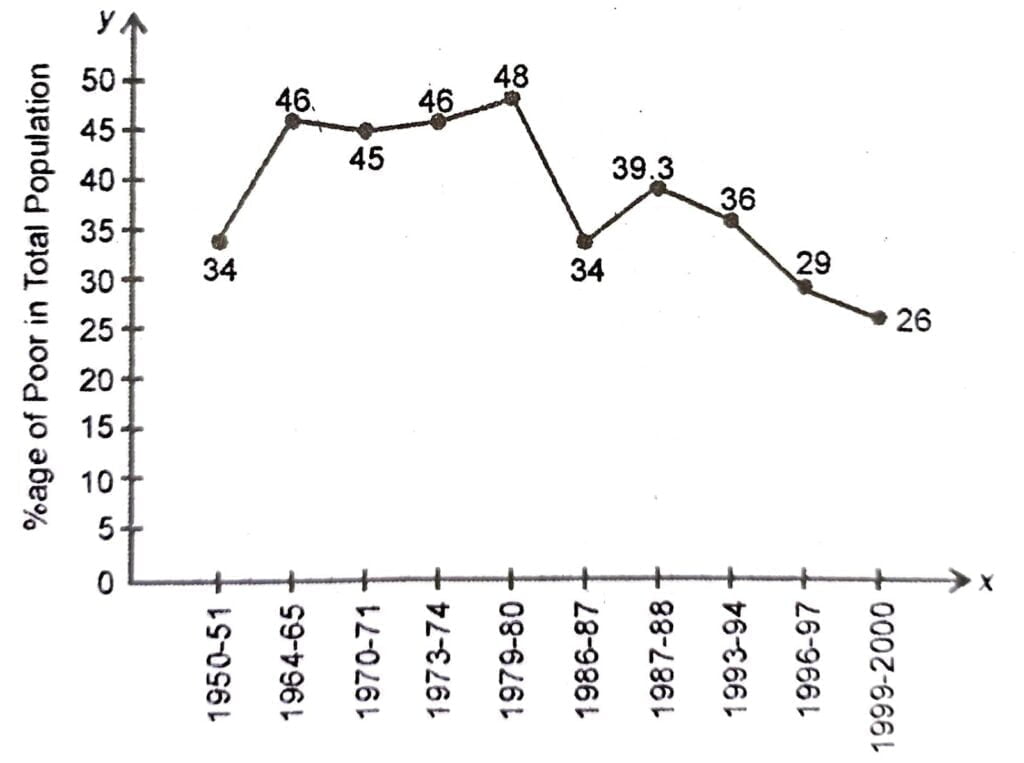
Q.10. Imaginary population of the following States in India is given below. Representation them by a bar chart.
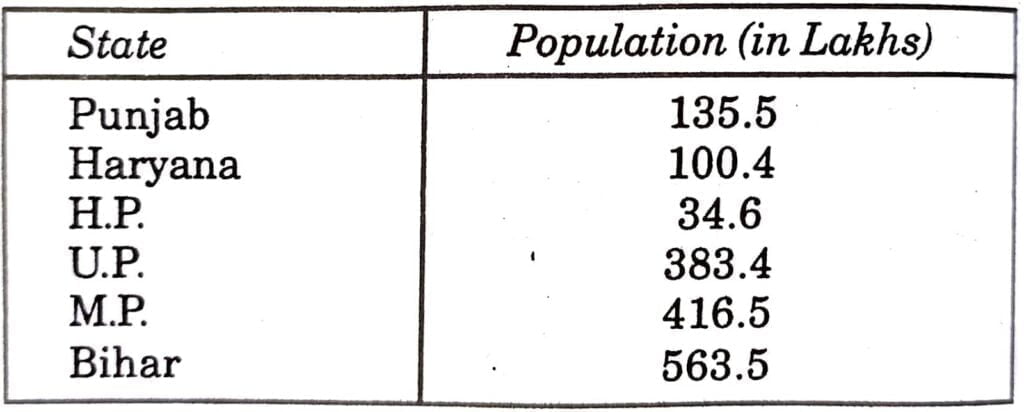
Ans. Population of the States in India.


Hi! my Name is Parimal Roy. I have completed my Bachelor’s degree in Philosophy (B.A.) from Silapathar General College. Currently, I am working as an HR Manager at Dev Library. It is a website that provides study materials for students from Class 3 to 12, including SCERT and NCERT notes. It also offers resources for BA, B.Com, B.Sc, and Computer Science, along with postgraduate notes. Besides study materials, the website has novels, eBooks, health and finance articles, biographies, quotes, and more.




